 |
surfresearch.com.au
the catalogue
#352
|
| home | catalogue | history | references | appendix |
 |
surfresearch.com.au
the catalogue
#352
|
| 1974 Gordon and Smith Surfboards Bonza 6 ft 8 1/2" |
#352
|

|
Length
:
|
6
|
ft |
8 1/2
|
inches | L2d | 6ft 7'' |
|
Width
:
|
19 1/2
|
inches |
Wide
Point :
|
+5
|
inches | |
|
Nose :
|
14
|
inches |
Tail :
|
12 1/2
|
inches | |
|
Thickness
:
|
3 1/2
|
inches |
Pod :
|
6 1/2
|
inches | |
|
Nose
Lift :
|
inches |
Tail
Lift :
|
inches | |||
|
Weight
:
|
kilos |
Volume
:
|
litres | |||
|
Swallow
:
|
-1 1/2
|
inches |
| FINS:
Centre fin : 6 inch x 6'' base x 8'' (span) @ 6''. Bonzer
/ Keel fins : 2" x 10'' base x 11'' (span) @
10'' |
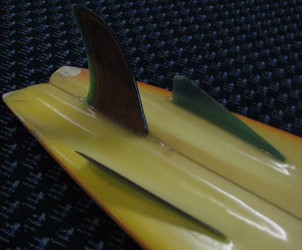 |
| DECOR
DECALS: Deck: Large Gordon and Smith enhanced script, multi coloured in shield with bird borders at centre. Bonza x 2 - towards nose and tail, image below. Bottom: Large Gordon and Smith enhanced script, multi coloured in shield with bird borders at centre. Hand shaped Tubeshooters by Peter Townend and Dolphin, towards the nose, image below. MARKINGS: Deck: None Bottom: |
 |
| COLOUR:
Deck Yellow spray on left rail, Orange spray on right rail, Volan 3/4 deck patch. Bottom Yellow spray on left rail, Orange spray on right rail. |
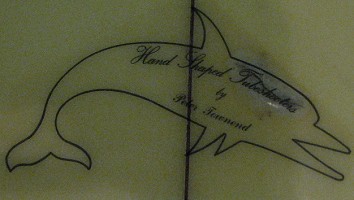 |
| NOTES
BOARD HISTORY Dimensions and images thanks to Mick Mock, Surf Auction, November 2011, #52. COMMENTS |
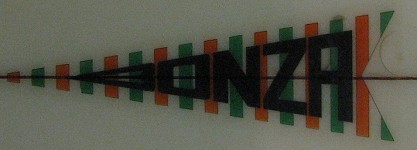 |
MANUFACTURER HISTORY
See Gordon and Smith Surfboards
REFERENCES.
Rabbit
Batholomew, pages
Other Gordon and Smith Boards:
# 109 1965 Gordon and
Smith, Noserider 9 ft 7"
# 26 1967
Gordon and Smith, Vee Bottom 7 ft 7"
# 72 1976
Gordon and Smith, Peter Townend Design 7 ft
# 73 1981
Gordon and Smith, Lazor Zap 6 ft
DESIGN
HISTORY
Original design
first shaped in December 1970 by Duncan and Malcom
Campbell (USA) characterised by forward concave leading
to double concave each side of the centre fin with two keel-
type fins set on the rails
(radically
toed-in and cambered).
See
http://www.bonzer5.com
The bottom
design has similarities with the shape of Rogallo hang
gliders, first designed in the late 1940's as a method of
recovering returning space capsules by NASA.
F. M. Rogallo
predicted in 1949 that "Portable delta wings will give
birth to a popular sport"
- quoted
in Desfayes (1974) page 41.
By the early
1970's, hang-gliding was a sport in rapid transition with a
large amount of media exposure.
As a sign of the powerful influence of Australia in world surfing at this time, the name Bonzer (also Bonzar, Bonza) is an Australian expression for “excellent”.
In late 1973,
the Campbell Brothers licensed the design to Bing
Surfboards for commercial development.
The design then
became associated with Bing's head shaper, Mike Eaton, who had
played a significant role
in the
development of the Twin fin 1 in 1970. See image and notes,
below.
The Bing models
were noted for the wedged Bonzer decal that was laminated on
the side fins.
Australian
exponents of the design included ...
Peter Townend
(Gordon and Smith Surfboards). See image below.
Ian Cairns
(Gordon and Smith Surfboards), rode a Bonzer to
first place, 1973 Smirnoff Contest, Laniäkea ,
Hawaii and
Terry Richardson (Skipp Surfboards). See image below.
It was a (admittedly complex) combination of previous design experiments - multiple fins were first used by Tom Blake circa 1940, tail concave by Bob Simmons in 1950, tri-fins by Brewer in 1970, keel fins go back to Blake and were re-introduced on short boards in 1972.
While some commentators have seen the Bonzer as a direct precedent for Simon's Thruster, its influence was probably substantially less significant than Brewer's Tri-fin experiments (that critically noted that placing the rail fins behind the centre fin made it "track", when positioned in front the board was "looser"), MR's Twin fin, McCoy's wide tailed No-Nose design, and of course the direct influence of Frank William's Twin-fin with a small centre trailing fin.
See: Cambell
Bros. Surfboards: History (July 2011)
http://bonzer5.com/history/timeline/1970-birth-of-the-bonzer/
A
personal perspective:
I briefly rode
a borrowed Bonzer in the mid-1970s, and like my
contemporaries, found the board very stiff and with a tendency
to hang high in the wave face.
A number of my
peers actually sanded the keel fins off and thought the board
went significantly better.
A local
manufacturer picked up on this and produced a number of boards
with the deep double concaves, but without the side fins, that
were well received.
In my search
for vintage boards, I have come across one example of a Bonzer
with the side fins removed, so I assume this was not just a
local phenomenon.
Further
adaptation in 1988, the Phazer - a Stinger/Thruster adaptation
( 3 similar fins with 2 small Bonzer
D-Fins)
initially credited to Rusty Priessendorfer for Rusty
Surfboards (USA).
Later
identified as another original design by the Campbell
Brothers.
See John Wythe
White :Surf Wars :The Bonzar, June 16,
1999
http://www.honoluluweekly.com/archives/coverstory%201999/6-16-99%20Boards/6-16-99%20Boards.html
|
Seen here with his 70's brain child 'the bonzer'." Photograph
: Drew Kampion Following
legal representation by the Campbell Brothers,
"Mike Eaton of California;
responsible for reviving the twin fin.
|
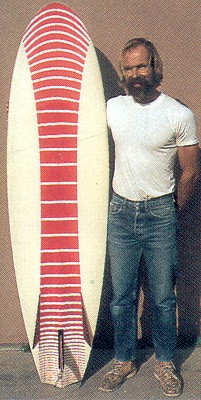 |
| REFERENCES OTHER BONZERS #180 South Coast Surfboards #198 Weber Bonzer MAGAZINES Articles 1. Jim Neece : The Bonzer Surfer magazine Vol 14 # 3 September 1973 page 64 See image below. 2. Steve Core: The Bonza Surfing World Volume18 Number 2. November 1973 3. Mick Mock : Richo's Choice Deep magazine , No 18 Spring 2000, pages 22 to33 4. John Wythe White: Surf Wars :The Bonzar, June 16, 1999 http://www.honoluluweekly.com/archives/coverstory%201999/6-16-99%20Boards/6-16-99%20Boards.html 5. Steve Barilotti : Belief System : The Bonzer Saga The Surfers Journal 2004? Volume 13 No. 2 pages? |
 Gordon and Smith Surfboards: PT Bonza. Tracks, December 1973. |
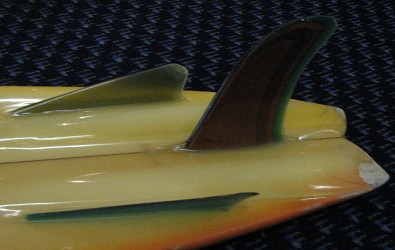 |
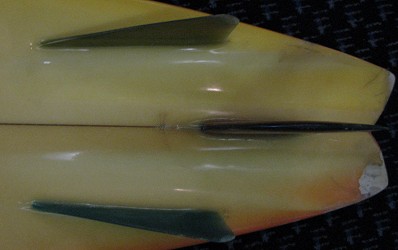 |
 
Conscripted surfresearch
assistant and G&S Bonza.
|
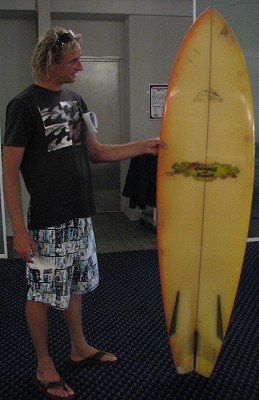 |
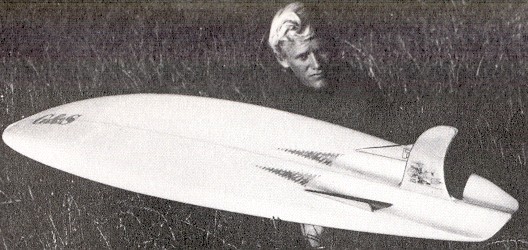 Above: Peter Townend and G&S Bonza, December 1973. Nat : Fundamentals (1985) page 102. Terry Richardson and Skipp
Surfboards Bonzer, circa 1975
|
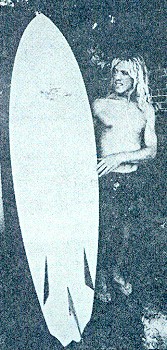 |
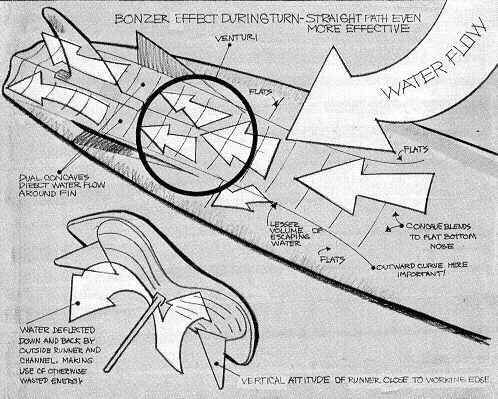 |
Jim Neece :"The Bonzer" Surfer Magazine Vol 14 # 3 September 1973 page 64 |
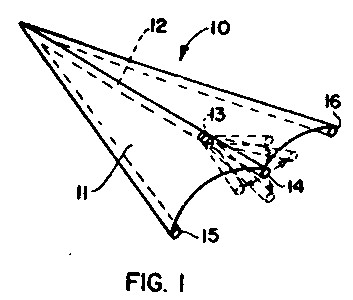 |
circa 1969. April 21, 1970 Patent Number 3,507,464 Filed March 18, 1969. From |
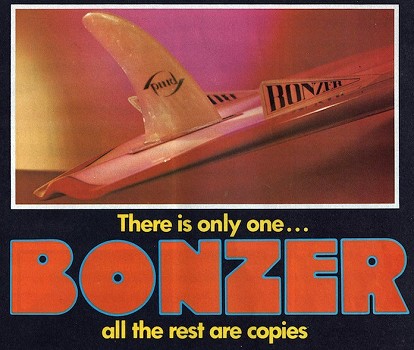 |
 Bing Surfboards :Only One Bonzer, 1973. Featuring the Campbell Brothers, Wildman (Jim Neece), Steve Wilkings, Jeff Kahman, Tiger Makin and Dru Harison. |
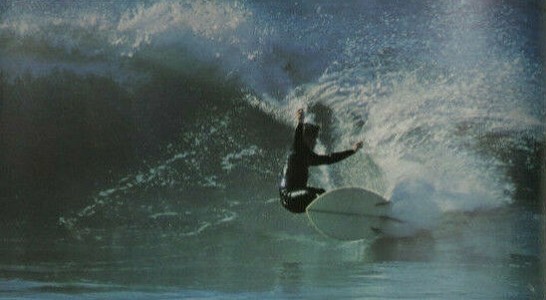 |
Surfing Comedy Album 1974. page 25. |

| home | catalogue | history | references | appendix |